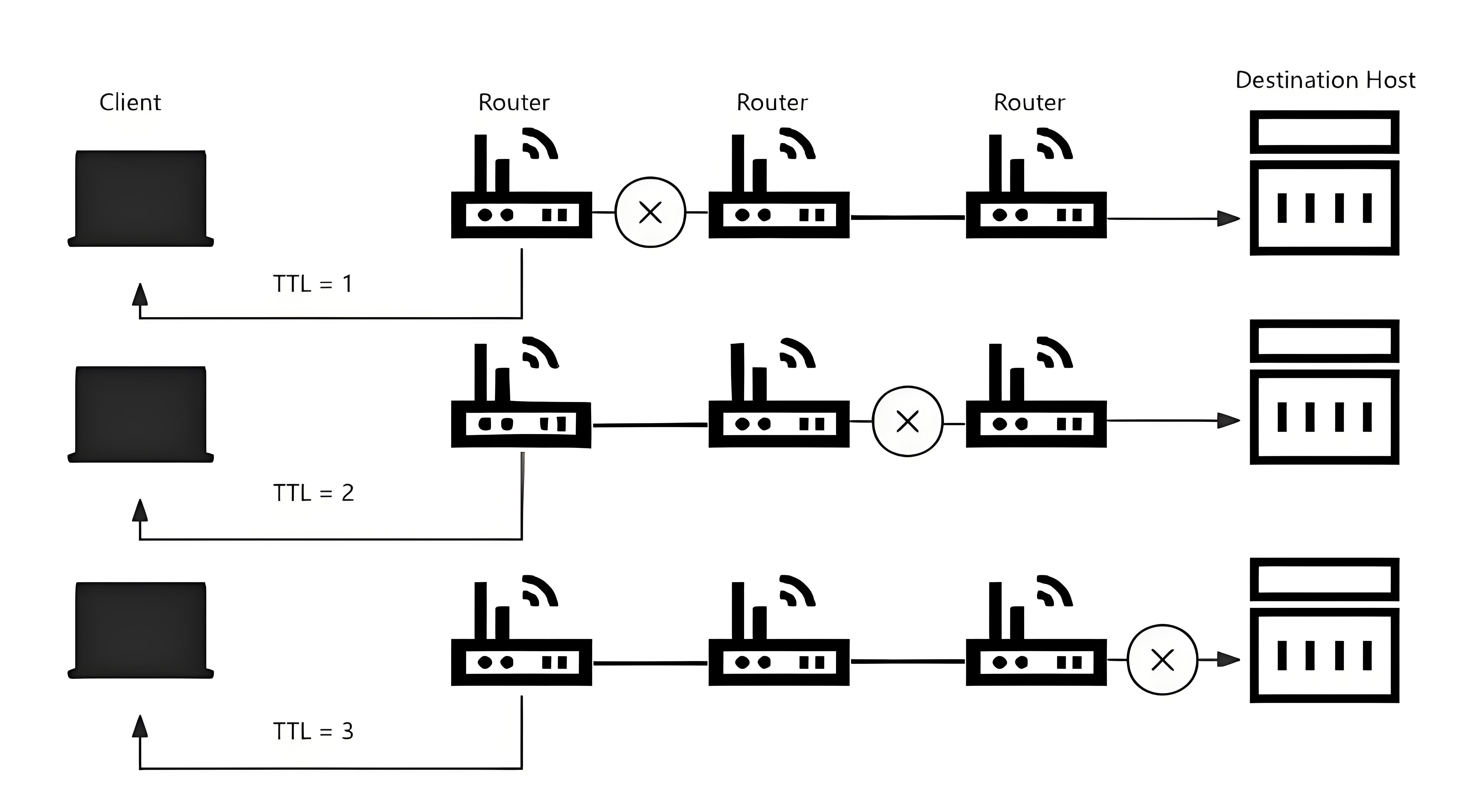Time to Live (TTL) is like a countdown timer for data traveling across the internet. Think of it as a stamped number on each piece of information that gets sent online. Every time this data passes through a connection point (called a router), the number goes down by one. When it reaches zero, the data is removed from the network.
This simple system helps in two main ways:
- It stops data from going around in endless circles.
- It keeps the internet from getting too crowded with lost data.
This makes the internet work better for everyone by keeping data moving efficiently and preventing network traffic jams.

What is Time to Live (TTL) in Networking?
In a network, Time to Live (TTL) is a value assigned to each data packet sent over the Internet Protocol (IP) network. This value indicates the maximum number of hops, or routers, that the packet can pass through before being discarded. Essentially, TTL acts as a timer that decreases by one each time the packet encounters a router, preventing it from endlessly circulating in the network.
How does TTL Work?
The principle behind TTL is simple yet effective. When a packet is created and sent into the network, it is given a specific TTL value. As the packet travels through each router on its path, this value is decreased by one. Once the TTL reaches zero, the router discards the packet and sends an ICMP Time Exceeded message back to the original source. This mechanism prevents packets from getting stuck in loops and ensures that only valid and necessary data reaches its intended destination.
For example:
- If a package starts with TTL = 5
- After passing through 1 router: TTL = 4
- After passing through 2 routers: TTL = 3
- And so on until TTL = 0, then the package is deleted
This simple system helps keep internet traffic moving smoothly and prevents network congestion.
The Purpose of TTL in Networking
TTL (Time to Live) serves several important functions within a network infrastructure:
- Loop Prevention: By limiting the number of hops a packet can make, TTL effectively prevents packets from entering infinite loops within the network.
- Resource Management: TTL helps optimize network resources by ensuring that packets do not unnecessarily consume bandwidth and processing power.
- Troubleshooting: Network administrators can utilize TTL values to trace the path of packets and identify potential issues along the way.
Other Uses of TTL
Beyond its primary function in network traffic management, TTL is also utilized in various other contexts:
- Traceroute Tool: The popular network diagnostic tool, traceroute, relies on TTL to map the path of a packet from source to destination, revealing each router it encounters along the way.
- DNS Caching: In the Domain Name System (DNS), TTL values determine how long DNS records can be cached by clients and servers, ensuring efficient resolution of domain names.
What is TTL in Pinging?
Standard network commands, or utilities, such as traceroute and ping, utilize the Time to Live (TTL) value to either reach a host or trace the route to that host. Ping is used initially to check whether a host is active on the network before employing traceroute. Traceroute records the route taken through the internet, showing each hop between a computer and a specified destination.
At each hop along the route, a packet containing a TTL value is decremented by 1. When the TTL value reaches zero, the packet is discarded, and an ICMP "Time Exceeded" message is sent back to the sender. Traceroute starts with a TTL value of 1 and increments it by 1 for each subsequent packet, continuing this process for each hop.
When it reaches the final hop, traceroute displays the recorded data, showing the route hop by hop.
What is TTL in DNS?
DNS TTL refers to the duration a DNS server can serve a cached DNS record. It acts like an expiration date for the record, instructing the local resolver on how long to keep it in its cache.
DNS resolution is the process of converting a domain name into an Internet Protocol (IP) address, ultimately connecting a user to a website. This process involves retrieving information stored in DNS records from various DNS servers and begins with the recursive or local DNS resolver, typically managed by an Internet Service Provider (ISP).
When a user enters a domain name into a web browser (initiating a DNS query), the recursive resolver queries a series of authoritative DNS servers to obtain the A record (for IPv4 addresses) or AAAA record (for IPv6 addresses), which indicates the corresponding IP address for the domain.
If the local resolver already has the required record in its cache, it can connect the user without performing the entire DNS lookup process. This efficiency reduces the query load on authoritative servers and significantly speeds up the time it takes for a user to access a website. The TTL value, defined in seconds, determines how long a local cache server can serve a DNS record before it must contact the authoritative server for an updated version.
Most IP addresses are dynamic and can change over time, so DNS records must be updated to reflect these changes. TTL settings help manage this process by ensuring that records are retired and updated at appropriate intervals.
Shorter TTL values are strategically used for websites that frequently refresh or update their content. These low TTL values help ensure that cached records on servers remain up-to-date and that changes are propagated in near real-time. Conversely, longer TTL values are suitable for DNS records that change less frequently, such as TXT records (which contain information about a domain's configuration and ownership) and MX records (which direct emails to an email server).
TTL values influence the query volume directed to the authoritative name server. If a DNS cache holds a record for too long, any changes to that record take longer to propagate, potentially slowing down a user's search or resulting in error messages. On the other hand, if TTL values are set too low, it can overwhelm servers with excessive queries. Managed DNS solutions can help ensure maximum uptime, streamlined observability, and rapid response and propagation times.
Conclusion
Time to Live (TTL) is a key concept in networking that determines how long data packets should remain in a network before they are discarded or refreshed. In the context of DNS, TTL specifies how long DNS records should be cached by resolvers. In IP networking, it prevents packets from circulating indefinitely by limiting the number of hops they can take through the network. Properly set TTL values are essential for maintaining network efficiency, reducing server load, and ensuring that data remains fresh. A clear understanding of TTL allows network administrators to optimize performance, manage cache durations, and control DNS propagation times effectively.
Tencent EdgeOne offers a variety of features related to Time-to-Live (TTL) settings that enhance website performance and caching efficiency. These features include:
- Node Cache TTL: Allows users to configure how long content is stored on edge nodes before it expires. This helps in reducing the load on the origin server and improves response times for end-users.
- Status Code Cache TTL: Permits the setting of TTL values based on different HTTP status codes, ensuring that specific types of responses are cached appropriately.
- Browser Cache TTL: Provides the capability to define how long content is stored in the end user's browser cache, optimizing the user experience by reducing reload times.
By offering customizable TTL settings, EdgeOne ensures that content delivery is both efficient and adaptable to varying requirements, improving overall website performance and user satisfaction.
We have now launched a Free Trial, welcome to Sign Up or Contact Us for more information.
FAQs
Q1: What is Time to Live (TTL)?
A1: TTL is a value that determines how long a data packet or record can exist in a network before being discarded or revalidated.
Q2: Where is TTL commonly used?
A2: TTL is used in networking, DNS caching, CDN caching, and data caching systems.
Q3: What happens when TTL expires?
A3: When TTL reaches zero, the data packet is discarded by routers or the cached record must be revalidated.
Q4: What does TTL=0 mean in DNS records?
A4: A TTL value of zero means that applications and DNS servers must not cache the record at all.
Q5: How does TTL work in network packets?
A5: In networking, TTL represents the number of "hops" a packet can make between routers before being discarded.

